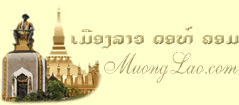|
|
Background
Modern-day Laos has its roots in the ancient Lao kingdom of Lan Xang, established in the 14th Century under King FA NGUM. For 300 years Lan Xang had influence reaching into present-day Cambodia and Thailand, as well as over all of what is now Laos. After centuries of gradual decline, Laos came under the domination of Siam (Thailand) from the late 18th century until the late 19th century when it became part of French Indochina. The Franco-Siamese Treaty of 1907 defined the current Lao border with Thailand. In 1975, the Communist Pathet Lao took control of the government ending a six-century-old monarchy and instituting a strict socialist regime closely aligned to Vietnam. A gradual return to private enterprise and the liberalization of foreign investment laws began in 1986. Laos became a member of ASEAN in 1997.
|
| Geography
Laos
is a landlocked country in the center of Indochina.
It shares borders with China and Burma to the north,
Cambodia to the south, Thailand to the west and
Vietname to the east.
Approximately
70% of its total area (236,800 square kilometers)
comprises of mountain and plateaux areas.
Mekong
river (one of the longest rivers in the world) forms
a natural border with Thailand. It flows through
almost 1,900 kilometers of the territory of Laos.
|
|
| Population |
|
the population of Laos was 6,677,534 (July 2008 est.). Around 85%
of the population are farmers and live in rural
areas. There are 3 main ethnic categories: Lao Loum
(low landers), Lao Thueng (lower mountain dwellers),
and Lao Soong (high landers). The great majority
of Lao are Buddhist.
Age structure: |
0-14 years: 41% (male 1,374,966/female 1,362,945)
15-64 years: 55.9% (male 1,846,375/female 1,885,029)
65 years and over: 3.1% (male 91,028/female 117,191) (2008 est.) |
Median age: |
total: 19.2 years
male: 18.9 years
female: 19.5 years (2008 est.) |
Population growth rate: |
2.344% (2008 est.) |
Birth rate: |
34.46 births/1,000 population (2008 est.) |
Death rate: |
11.02 deaths/1,000 population (2008 est.) |
Net migration rate: |
NA (2008 est.) |
Sex ratio: |
at birth: 1.05 male(s)/female
under 15 years: 1.01 male(s)/female
15-64 years: 0.98 male(s)/female
65 years and over: 0.78 male(s)/female
total population: 0.98 male(s)/female (2008 est.) |
Infant mortality rate: |
total: 79.61 deaths/1,000 live births
male: 88.9 deaths/1,000 live births
female: 69.88 deaths/1,000 live births (2008 est.) |
Life expectancy at birth: |
total population: 56.29 years
male: 54.19 years
female: 58.47 years (2008 est.) |
Total fertility rate: |
4.5 children born/woman (2008 est.) |
HIV/AIDS - adult prevalence rate: |
0.1% (2003 est.) |
HIV/AIDS - people living with HIV/AIDS: |
1,700 (2003 est.) |
HIV/AIDS - deaths: |
fewer than 200 (2003 est.) |
Major infectious diseases: |
degree of risk: very high
food or waterborne diseases: bacterial and protozoal diarrhea, hepatitis A, and typhoid fever
vectorborne diseases: dengue fever, Japanese encephalitis, and malaria
note: highly pathogenic H5N1 avian influenza has been identified in this country; it poses a negligible risk with extremely rare cases possible among US citizens who have close contact with birds (2008) |
Nationality: |
noun: Lao(s) or Laotian(s)
adjective: Lao or Laotian |
Ethnic groups: |
Lao 55%, Khmou 11%, Hmong 8%, other (over 100 minor ethnic groups) 26% (2005 census) |
Religions: |
Buddhist 67%, Christian 1.5%, other and unspecified 31.5% (2005 census) |
Literacy: |
definition: age 15 and over can read and write
total population: 68.7%
male: 77%
female: 60.9% (2001 est.) |
School life expectancy (primary to tertiary education): |
total: 9 years
male: 10 years
female: 8 years (2006) |
Education expenditures: |
3% of GDP (2006) |
|
| Climate |
Laos has a warm and tropical climate
with two seasons: the rainy season from the beginning
of May to the end of September and the dry season
from October to April. The average temperature 29
degree centigrade. Maximum temperature can reach
up to 40 degree centigrade. Temperatures can drop
to as low as 15 degrees or even lower in mountains.
Generally, tourists are recommended to visit Laos
during the months of November to March because these
are cool months and rainfall is lower than other
periods.
|
| Language |
The official language used in Laos
is Lao language. However, the usage of the language
can differ from north and south. English, French
and Russian are spoken in business or by some senior
government officials. Many shopkeepers can understand
basic English and French.
|
| Electricity
& Water |
| Laos uses 220 volt (50 Hz) electricity
for use with either two-pronged round or flat plugs.
It is not recommended to drink directly from taps
since it is not very clean. However, purified water
is available throughout the country.
|
| Currency |
|
Lao national currency is Kip. There
has been some devaluation of Lao Kip in the past
few years. There are exchange booths available throughout
town. Major credit cards are also accepted in large
shops. You can also withdraw cash by using your
credit cards, but it has to be done at a bank, since
there is no automatic teller machine in Laos just
yet.
|
| Communication
Facilities |
|
Public phones are available in
Vientiane and other major cities. You can also go
to Lao Telecom office to call and fax overseas.
Phone cards are widely available in most convenient
stores. There are a number of Internet cafes in
Vientiane and major cities. So you can be sure that
you can always keep in touch with your family and
friends. |
|
| |

|
|
